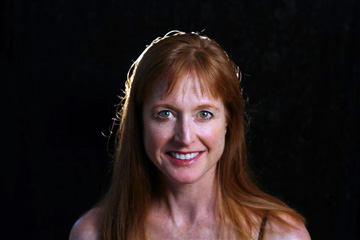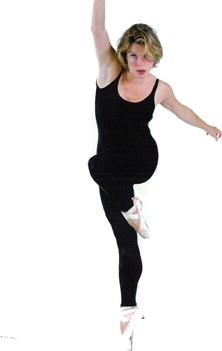Tokens of Times Past
Bowen McCauley Dance
Millennium Stage North
The John F. Kennedy Center for the Performing Arts
Washington, DC, USA
November 19, 2006
by George Jackson
copyright 2006 by George Jackson
 The tilt of a neck or the hemline of a dress may remind us of the elusive past, but so can titles and musical timbres. Four of the premieres on this five part program prodded memory in at least one way. “Souvenirs — Souvenirs”, Juan Carlos Rincones’s first new choreography in some time, did so stylishly by way of the fashions worn, the accompanying chansons, the very name of the piece and, not least, the dancing.
The tilt of a neck or the hemline of a dress may remind us of the elusive past, but so can titles and musical timbres. Four of the premieres on this five part program prodded memory in at least one way. “Souvenirs — Souvenirs”, Juan Carlos Rincones’s first new choreography in some time, did so stylishly by way of the fashions worn, the accompanying chansons, the very name of the piece and, not least, the dancing.
There was no program note but I found myself back in the Hollywood of “The Women” and “A Letter to 3 Wives”.* In a remarkable all-female cast of five, each dancer deserved to shine. Rincones gave them the chance to do so as solo figures and when sharing the stage. The women were clad in off-white cocktail gowns cut with classic chic and made of material that swirled flatteringly. Lucy Bowen McCauley, looking very Greer Garson with her orange hair swept up, seemed a custodian of civility. Alison Crosby, moving with a bold authority, was perhaps the would-be rebel. The other three — Kristin Brown, Alexandra Buss and Heather Lyle — tested themselves, hoped and considered. Heads were held high on proud necks. Heeled shoes gave much of the dancing a ballroom glide but in some solo moments the steps crystallized and one could almost see them being done on pointe.
The café songs being danced (“music by Barbara”) were smoothly au lait and bittersweet in a worldly way, from the opening “Le mal de vivre” to the sixth and final “Ma plus belle histoire d’amour”. One less number wouldn’t have hurt, but which of his cast would Rincones have short changed? The individually striking performances meshed into true ensemble. Thomas Pheasant’s designs for the gowns, executed by Joan Lynch, were essential.
“Bowing”, the other brand new work, was to Benjamin Britten’s “Suite for Solo Cello #1” and that, I think, constituted its story. Britten, coming after the great 20th Century modernist explosion — Schoenberg, Stravinsky, Hindemith, Bartok et al. — stepped aside from Western classicism’s radical line. Instead of advancing to musique concrete, minimalism and electronics, he integrated dissonance and consonance, the atonal and tonal, revolution and tradition and did so in a-modernist ways that were very mid-20th Century. Bowen McCauley’s balletic choreography to the Britten score was sturdy, square and sensible like some of the first architecture built after World War 2. Scored for four women (Brown, Buss, Crosby and Lyle) and two men (Dustin Kimball and Robert Sidney), it looked solidly crafted but, as with the Rincones, less might have been more if during one of the music’s sections we had just been given Yvonne Caruthers’s cello playing unaccompanied by dancing. Bowen McCauley dedicated her other premiere, a U.S. one, to Hanna Hoech and Dada art. “Hannah, You There?”, a pas de trios, emerged as comedy. Mostly, though, it was the Francis Poulenc music that alluded to Dada and the 1920s. The choreography wasn’t wicked enough and Susan Chiang’s costumes didn’t quite click either.
As a title, “Hand-Me-Down Trousers”, evokes lean years such as those of America’s agricultural busts and the big Depression. The dance that went with that heading, Alvin Mayes’s duo for brothers (“They knew … by our haircuts and hand-me-down pants”), neatly displayed the relationship’s rough-housing and also its affection. Sidney as one of the pair and Tommy Parlon as the other, enjoyed romping to Keiko Abe’s variations on Japanese children’s songs. Further light fun was Bowen McCauley’s “Mua Mua Mua”, a dance for children — 20 girls and 1 boy — from the Kenmore Middle School in Arlington.
 The regular Bowen McCauley Dance company was in fine form. Alison Crosby, appearing in three of the ballets, shone. Although she’s part of a Washington generation that has retired now or scaled back — Susan Jaffe, Cheryl Yeager, Amanda McKerrow, et al. — Crosby (who combines Marina Semyonova’s sculptural classicism with fleet American traits) is going strong as ever.
The regular Bowen McCauley Dance company was in fine form. Alison Crosby, appearing in three of the ballets, shone. Although she’s part of a Washington generation that has retired now or scaled back — Susan Jaffe, Cheryl Yeager, Amanda McKerrow, et al. — Crosby (who combines Marina Semyonova’s sculptural classicism with fleet American traits) is going strong as ever.
>>>>>>>>>>>>>>>>>>>>>>>>>>>>>>>>>>>>>>>>>>>>>>>>>>
* The first filming of “The Women” was in 1939; “A Letter to 3 Wives” was a 1949 movie initially with the working title “A Letter to 5 Wives”. Rincones’s ballet can also be seen as a transplant of Lorca’s “The House of Bernarda Alba” into a genteel, upper class American milieu.
Photos:
Top, Lucy Bowen McCauley. Photo by by John McCauley.
Botton, Alison Crosby.
Volume 4, No. 42
November 27, 2006
copyright ©2006 George Jackson
www.danceviewtimes.com